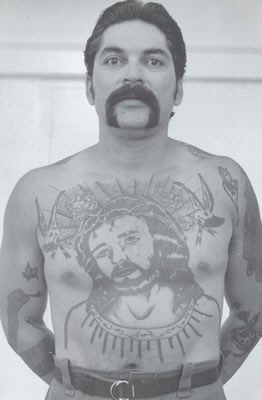




click on thumbnails below to see
The Tattoos:
20th Century Tattoos For most of the 20th century, tattoos remained relegated to military servicemen, the lower, working classes and their low culture. Tattoos “fragmented” in the 1960’s, however, and were used as important identity symbols for bikers, prison convicts, punks and the gay/leather subcultures of the American west coast (DeMello 2000:70). This fragmentation, the beginning of what was to become the “tattoo renaissance,” lead to the ultimate mainstreaming of tattoos as icons of popular culture in the 1980’s and 1990’s. With the “tattoo renaissance,” tattoos came to be seen as an anthropological, sociological and ethnographic phenomenon tied to changing views of the human body. Tattoo anthropologists and ethnographers studied and entered tattoo subcultures to better understand why this particular method of body modification has literally exploded in western culture. For in-depth studies on tattoos and body modification, see Atkinson (2003), DeMello (2000), Featherstone (2000), Hewitt (1997), Mascia-Lees and Sharpe (1992), Sanders (1989), Siebers (2000) and Sullivan (2001). Still haven't decided on a design? Have a look at the Tattoos. Or, study the Subcultural Tendencies. |
 |





'Under the Skin', Copyright 2004, Tony Hewer.

